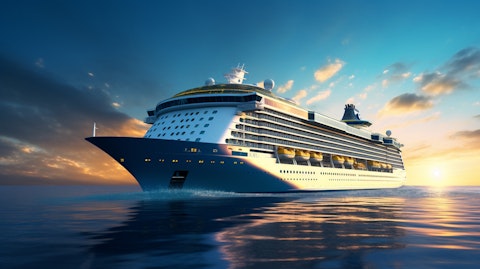Carnival Corporation & plc (NYSE:CCL) Q4 2023 Earnings Call Transcript December 21, 2023
Carnival Corporation & plc beats earnings expectations. Reported EPS is $-0.07, expectations were $-0.12. CCL isn’t one of the 30 most popular stocks among hedge funds at the end of the third quarter (see the details here).
Operator:
Beth Roberts: Good morning. This is Beth Roberts, SVP Investor Relations. Welcome to our Fourth Quarter 2023 Earnings Conference Call. I’m joined today by our CEO, Josh Weinstein, our Chief Financial Officer, David Bernstein; and our Chair, Micky Arison. Before we begin, please note that some of our remarks on this call will be forward-looking. Therefore, I will refer you to the cautionary statement in today’s press release. All references to ticket prices, net per diem, net yields and adjusted cruise costs without fuel will be in constant currency unless otherwise stated. References to per diems and yields will be on a net basis. Our comments may also reference cruise costs without fuel, EBITDA, net income, net loss, earnings per share, free cash flow and ROIC, all of which will be on an adjusted basis, unless otherwise stated.
All these references are non-GAAP financial measures defined in our earnings press release. A reconciliation to the most directly comparable U.S. GAAP financial measures and other associated disclosures are also contained in our earnings press release and in our investor presentation. Please visit our corporate website where our earnings press release and investor presentation can be found. With that, I’d like to turn the call over to Josh.
Josh Weinstein: Thank you, Beth. It’s safe to say we ended the year on a high note and closed another quarter with record revenues, record booking levels and record customer deposits. In fact, we consistently set records in all four quarters this past year. We also achieved per diem EBITDA and net income for the fourth quarter that all exceeded the high end of our September guidance range with cruise cost ex fuel in line with expectations. Fourth quarter yields continued on a positive trajectory, significantly higher than a very strong 2019 and even higher than we had anticipated and enabled us to overcome four years of high cost inflation to deliver per unit EBITDA that eclipsed 2019, holding fuel and currency constant. It was encouraged to see both North American and European brand occupancy levels exceed 101% in the fourth quarter with per diems for our North American brands up double-digits over 2019 and our European brands just shy of a double-digit increase.
We delivered per diem improvements of more than 7-points for the full year with even stronger acceleration in Q4 while closing the double-digit occupancy gap at the start of the year to reach historical levels for the second half of 2023. An absolute spending on board was consistent across all four quarters as we drove improvement in ticket prices. We delivered $85 million more to the bottom line in the fourth quarter than forecasted, which pushed us through to positive adjusted income for the year. Strong EBITDA and cash from operations also propelled us on our journey to reduce the debt load necessitated during the pause in operations. We made debt payments of $6 billion this year ago, and we still have well over $5 billion of liquidity on top of strong and improving cash flow, which will contribute to further debt reduction over time.
All of this leaves us firmly placed on our path back to achieve investment grade leverage metrics by 2026. And most importantly, our brands delivered happiness to over 12 million guests this year, laying the foundation upon which all of our SEA Change targets are built. Turning to bookings. We reached an all-time high in booking volumes for the two weeks around Black Friday, Cyber Monday and ended the year in the best booked position we have ever seen on both price and occupancy setting 2024 off to an amazing start. We now have nearly two-thirds of the business on the books for 2024 and that considerably higher prices. And during the fourth quarter, we essentially maintained the significant occupancy advantage we have built for 2024 going into the quarter, while improving year-over-year price position of our booked business even further.
At this point, much of the first half is already behind us. With approximately 85% of the business on the books, we’ve essentially closed the double-digit occupancy gap to historical levels on higher capacity and at higher prices. For our peak summer period, all major products are better booked at higher prices benefiting from improving trends in both occupancy and price during the fourth quarter. Our yield management strategy, the baseload bookings has clearly set us up for another record year. And again, we have seen no sign of our business slowing. The book position for our North American brands remains as far out as we have ever seen and well ahead of last year, and pricing that is considerably higher. Our European brands just delivered record fourth quarter booking volume at considerably higher prices and with a booking window now fully back to historical norms.
As expected, our European brands are poised to become an even greater contributor to our 2024 operating improvement. At the same time, we are continuing to pull forward onboard revenue through bundling and pre-crew sales. This strategy, coupled with even more features onboard our newer ships for our guests to enjoy positions us well for further onboard revenue growth next year. Also, we expect occupancy for the full year to return to historical levels on 5% higher capacity, while delivering nicely higher per diems dam building on this year’s record results. In 2023, we captured over 3.5 million new to cruise guests and remain well-positioned to continue to take share from land-based alternatives. In other words, we are gaining momentum in our ability to close the unwarranted value gap to land-based alternatives.
And to aid in that effort, we can further chance the fact that while many land-based alternatives have pulled back on service levels. We still deliver incredible service to our guests, thanks to our amazing crew. This pair is exceedingly well with the expansive amount of guest-pleasing amenities offered on board our newer fleet. In fact, while almost four years have passed since the pause in our operations, our fleet actually came out of the pause a year younger through our fleet optimization efforts. This past year alone, we benefited from three fantastic new ships, including Carnival celebration and P&O Cruises. Arvia, both of which are flagships for their respective brands yet leverage our scale as the seven and eight vessels in our popular and exceptionally efficient series of XL class ships, and we welcome Seabourn Pursuit, our second expedition ship.
Seabourn Pursuit has truly raised the bar for expedition cruising in extreme luxury. And while not technically new, Carnival Cruise Line also welcomed Carnival Venezia into its fun Italian-style platform via the transfer from Costa and it has been going gangbusters. It’s the biggest example yet of how we leverage our scale and we’ll be doubling down when we bring over her sister ship Carnival Firenze in 2024. Looking forward, this year is set to match the excitement level with the introduction of Carnival Jubilee, a new icon for Carnival Cruise Line and which no doubt will be the pride of Texas as she has her inaugural home in Galveston The innovative Sun Princess, the first of its class and a real game changer for Princess and Queen Anne, a new flagship for Cunard and its first new ship in 14 years.
With all of these additions roughly 30% of our capacity will be newly delivered ships. We also made meaningful headway on other strategic asset projects. We began construction on Celebration Key which will be the largest and closest exclusive destination in our destination portfolio and a real game changer for Carnival Cruise Line. We’ll bring 18 Carnival ships departing from nine home ports to Celebration Key and while we are still about 1.5 years from Go-Live, we are already ramping up the awareness and excitement around the fantastic destination. We’ve also started the process for a significant upside in guest traffic at Half Moon Cay, our exclusive and beautiful pristine island destination in the Bahamas, with the creation of a pierside berth that can accommodate even our largest vessels.
We’ve begun work with our Grand Bahamas shipyard partners on the construction of two floating dry docks, one of which will have the largest lifting capacity in the world. This will result in significant benefit in the future as we reduce travel time, preserve revenue days and, at the same time, reduce our fuel consumption. As you know, we’ve also been investing more in advertising over the last 18 months, and it has definitely paid off with elevated awareness and consideration for our brand and record booking levels and revenue results. In fiscal 2023, our web visits were up over 35%. Our paid search was up roughly 50% and our natural search was up almost 75%, all many, many multiples of our 5% capacity growth. In the fourth quarter, we carried more new to cruise, have more new-to-brand guests than we did in the fourth quarter of 2019.
Given our success and generating demand at this point in time, we plan to maintain a similar level of advertising on a unit basis in 2024 compared to 2023, optimizing around each brand. This will help us continue to build demand and bookings well outside of the current year. We’re working aggressively to keep our strong momentum going through waves and beyond. Just to list a few examples Costa recently launched spectacular new campaign in its core markets, focusing on moments where guests are left speechless. Holland America, launched a sequel to its highly successful Time of Your Life campaign and AIDA just kicked off its new campaign experience yourself differently in conjunction with the holiday Carnival will launch a new marketing campaign highlighting Celebration Key in time for P&O Cruises new campaign, Holiday Like Never Before, launches Christmas Day in the U.K. and Cunard has planned a welcome Fit For A Queen to introduce Queen Anne early next year, which is sure to capture huge fanfare.
We’ve been talking about upping our game across the commercial space. And we’ve made good progress. Of course, we’re not done. And as you’d expect, we never will as there is always room to improve. There’s much more to come, as we rolled out advancements to our yield management tools and lead generation techniques, continue to invest in sales and sales support and build on already strong relationships with our trade partners. Tuning to cost, as we previously indicated, new-to-cruise costs ex-fuel for 2024 are expected to be higher than inflation due to the impact of closing the occupancy gap and the higher volume or dry-dock days. David will walk you through in more detail. But that said, we have been working aggressively to mitigate inflation through our cost optimization initiatives, including leveraging our scale.
In some cases, we’re investing today for future benefits. Just to cite a couple of examples of initiatives underway, we’re essentially complete with the rollout of sterling across the globe. This will produce more than a 20% reduction in cost per ALBD in 2024 and significantly increase our bandwidth pipeline, resulting in both, better guest experience and higher onboard revenues, a clear win-win. And with our new Vendor-Neutral platform, we are positioned to quickly capture cost savings in future years. We’ve also launched our Maritime Asset Strategy Transformation, or what we refer to internally as MAS. MAS is a centralized system developed to optimize the management of equipment and machinery across all brands and all of our ships. MAS will allow us to leverage spare parts more effectively across the entire fleet and optimize our maintenance schedules and practices, all of which will strengthen our efficiency and reduce unplanned maintenance overtime.
Well, we won’t see the P&L benefits for MAS this year as we ramp up its implementations in 2024. We expect a multiyear benefit, well in excess of $100 million that really begin to ramp up in 2026. All the efforts we’re making to drive revenue and manage cost are expected to lead to a four point margin improvement in 2024. We’re going to record EBITDA of over $5.5 billion, which is 30% higher than 2023. Thanks to a strong second half of 2023. We’re already tracking ahead of our plan to achieve the change our three year financial targets, calling for the highest ROIC and EBITDA per ALBD in nearly two decades. And our 2024 guidance delivers another step change toward these deliverables. EBITDA per ALBD is expected to be up by more than 25% over our target starting point and to more than halfway to the 50% increase expected, in our SEA Change targets.

Today’s guidance but also delivered 9% ROIC of four point increase from the starting point of our targets. This leaves just 1.5 point annual increases in 2025 and 2026 to hit our 12% target. Not surprisingly, our brand dedicated to a single market. Carnival, AIDA and P&O cruises in the U.K. are again leading the charge with the highest ROIC levels in the company. And with regard to our greenhouse gas target, included in our 2026 SEA Change Program, our GHG Intensity in 2024 is expected to be just shy of the 20% reduction from 2019 were targeted. It’s worth noting, this was a 2030 goal. We had already pulled forward by four years. We have been and continue to work aggressively to reduce our environmental footprint and fuel costs at the same time.
This deep commitment has not only resulted in industry-leading fuel efficiency but it has also resulted in lower absolute GHG emissions. Our absolute emissions are over 10% lower than the 2011 peak and that’s despite capacity growth of 30% since then. Last year, we also exceeded our industry-leading shore power capability goals. We are ahead of the curve and now have twice as many ships capable of shore power than there are ports around the world available plug into. Again, I credit all of these important achievements to our people, ship and shore. Collectively, they continue to outperform, allowing us to make good headwind on our SEA Change targets. We’re poised for another step change in operating improvement this year with nearly two-thirds of the business on the books at considerably higher prices, ongoing momentum from improvements across the commercial space, the amazing vacation experiences we deliver day-in, day-out at way too good over relative value to land-based alternatives and an even greater experienced staff, all while growing onboard revenues and managing costs.
All of this combined sets us up well to deliver another year of record revenues and record EBITDA. Our cash flow strength, coupled with excess liquidity, the return of credit card reserves in a few weeks and the lowest order book in decades will allow us to continue to actively manage down debt and aggressively reduce interest expense over time. It will also propels us on our path to deleverage investment-grade credit rating and higher ROIC. I remain confident in our continued execution with an unparalleled portfolio of best-in-class brands and amazing fleet that just keeps getting better and better, and our greatest assets are people. This has been a truly remarkable year, and we’ve come a long way in an incredibly short amount of time. I would like to thank our team members, ship and shore, the best in all of traveling measure travel and leisure unforgettable happiness to over 12 million guests this year by providing them with extraordinary cruise vacations for honoring the integrity of every ocean we sail, place we visit and life we touch.
And thank you for the strong support from our travel agent partners as well as our royal guests, destination partners, investors and many other stakeholders. With that, I’ll turn the call over to David.
David Bernstein: Thank you, Josh. I’ll start today with a summary of our 2023 fourth quarter and full year results. Next, I will provide a recap of our refinancing and deleveraging efforts during 2023 and finish off with some color on our 2024 full year and first quarter December guidance. Our fourth quarter bottom line exceeded the better end of our guidance range as we outperformed our September guidance. The $85 million improvement was driven by favorability in revenue from higher ticket prices as net per diems were up over 10%, 3-points better than the midpoint of our September guidance range. In fact, fourth quarter revenues of $5.4 billion for a fourth quarter record and net yields were up nearly 8% as compared to 2019, a great way to close out the year and another indication that we do not see a slowdown in our consumers.
For the full year, thanks to the tremendous efforts of our team members, ship and shore, we closed the books on 2023 with positive adjusted net income. That is a far cry from our March guidance as we delivered over $550 million to the bottom-line, which was partially offset by a drag from fuel price and currency exchange rates of over $100 million. The improvement was driven by delivering a 7.5% increase in net revenue per diem versus 2019, which was over double the 3.5% midpoint of our March guidance, while closing the double-digit occupancy GAAP at the start of the year to reach historical occupancy levels. Absolute spending per diems on board were consistent across all four quarters as we drove improvements in ticket prices on both sides of the Atlantic and ended the year with net yields of nearly 1% over 2019.
Next, I will provide a recap of our refinancing and deleveraging efforts during 2023. As Josh indicated, our full year 2023 strong EBITDA of $4.2 billion and strong cash from operations of $4.3 billion, propelled us on our journey to pay down debt and reduce the debt burden necessitated by the pause in guest cruise operations. During 2023, we made debt payments of $6 billion and ended the year with just over $30 billion of debt, which is $3 billion better than we forecasted just nine months ago during our March conference call and almost $5 billion of the first quarter peak transferring enterprise value from debt holders to shareholders. During 2023, we proactively addressed our debt profile as we successfully started our refinancing and deleveraging program.
We accelerated our debt repayment efforts and aggressively manage down our interest expense. In 2023, we effectively stretched out the 2025 maturity on favorable terms by replacing it with a $1.3 billion term loan B facility in 2027 and a $500 million offering of senior secured notes in 2029. This refinancing, along with our optimism about our future and the return of customer deposit reserves gave us some confidence to accelerate our debt repayment by calling $1.2 billion of our highest cost debt. In addition, we opportunistically prepaid $2.8 billion of additional debt for a total of $4 billion of debt repayment including the $1.2 billion of debt cost. Our credit card processes returned to us $800 million of credit card reserves, and we now expect an additional $800 million to be returned this current quarter representing substantially all of the remaining credit card reserves at year end.
We took actions in both 2022 and early in 2023 to increase the fixed rate percentage of our debt portfolio to over 80% up significantly from our 58% fixed levels at the end of 2021, which provided us protection from rising interest rates. Our overall average interest rate is just over 5.5%. All these actions will address our debt profile alongside our improved business performance. So $200 million of interest savings compared to our March guidance. On maturity powers have been well managed in 2026 with just 2.1 billion of debt maturities next year, 2.2 billion in 2025 and 3.2 billion in 2026. And looking forward, we will continue to evaluate refinancing opportunities and opportunistically pre-pay additional debt. During 2024 we will be replacing higher cost fixed rate debt with lower cost export credit financing as we take delivery of ships during 2024.
Our leveraged metrics will also continue to improve throughout 2024 as our EBITDA continues to grow. Now turning toward 2024 full year, December guidance. We are forecasting a capacity increase of about 5.5% compared to 2023. We are expecting to deliver strong 2024 net yield improvement with our guidance forecasting an increase of approximately 8.5% for the full year 2024 compared to 2023. And that is on top of improved 2023 results where we delivered a 7.5% increase in net revenue per diems versus 2019. The strong improvement in 2024 net yields is a result of the increase in all the component parts, higher ticket prices, higher onboard spending and higher occupancy with all three components improving on both sides of the Atlantic. We are well positioned to drive 2024 ticket prices higher with significantly less inventory remaining to shell and the same time last year, despite a capacity increase of over 5%.
Occupancy for the full year 2024 is on track to return to historical level. Keep in mind 2019 with a high watermark for occupancy. The 2024 forecast to be well within our historical occupancy range as we balanced pricing values to optimize total revenue and achieved record yields. Now turning to costs. Cruise costs without fuel, per available lower per day where ALBD is currently expected to be up approximately 4.5% for 2024 versus 2023. Broadly speaking there are four main drivers of costing. First, our forecast is for decelerating inflation. But nonetheless inflation with an average 3.5% increase across all our cost categories globally. Second, with occupancy returning to historical levels, the impact on costs should be 1.5 to 2 percentage points higher in 2024 as compared to 2023.
Third in 2024, we are expecting at 586 dry-dock days, an increase of 14% versus 2023, which is expected to impact our overall year-over-year cost comparisons by about 0.75. And four countering these headwinds, we expect these cost increases will be somewhat mitigated by a couple of points. Given economies of scale build our capacity growth, which is enhanced by taking delivery of larger and more efficient ships along with various other cost optimization initiatives. Fuel consumption per berth day is expected to decrease another 4% and that is on top of the 15.5% production achieved from 2019 to 2023. The net impact of fuel prices and currency is expected to favorably impact 2024 by $90 million with lower fuel prices favorable but $94 million while the change in currency exchange rates slightly goes the other way.
And finally, a few things to note about the outsized increases in the first quarter of 2024, a higher net yield guidance for first quarter of 2024, of 16.5% versus the full year 8.5% is driven by the larger improvements in first quarter occupancy. Let’s not forget that we did not reach historical occupancy levels into the second half of 2023. So there was much more occupancy driven net yield opportunities in the first half. On the cost side, the higher cruise costs without fuel per available lower berth day guidance for the first quarter of 2024 and 9.5% is driven by four main factors. First, the largest improvement in occupancy will occur in the first quarter. However its drives greater yield increases in the first quarter, it also drives greater cost increases, which means a total of three to four points cost drag in the quarter.
Second, while dry-dock cost impact of full year guidance, the seasonality of dry-dock costs in the first quarter of 2024 as compared to the prior year drives the cost increase of about1.5 points to this quarter. Third, the seasonality of advertising expense and a variety of other expenses between the quarters, this was in 2024, as compared to 2023 which will put a total cost increase of approximately three points into this quarter, advertising alone is one of the three points. And four, like the full year inflation mitigated by economies of scale, our capacity grows along with various other cost optimization initiatives, given a higher first quarter cruise costs without fuel per available per berth day, the implied guidance to the cost in the second to the fourth quarter is approximately 3%.
In summary, putting all these factors together our net income guidance for the full year 2024 is approximately 1.2 billion with EBITDA forecasted at 5.6 billion, a significant improvement from 2023. For those of you who are modeling EPS, let’s not forget that when you calculate diluted EPS, you need to add back to $94 million of interest expense related to the company’s convertible notes or improved financial results and are successful refinancing and deleveraging efforts in 2023 along with our 2024 December guidance this is firmly placed on our paths to achieve our 2026 teaching seeking goals, moving us further down the road to rebuilding our financial fortress and delivering longer term shareholder value. And now, operator, let’s open up the call for questions.
Operator: [Operator Instructions] Our first question comes from Steve Wieczynski with Stifel. Please proceed.
See also 14 Most Profitable Large Cap Stocks to Buy and 40 Cities with the Highest Life Expectancy in the US.
Q&A Session
Follow Carnival Corp (NYSE:CCL)
Follow Carnival Corp (NYSE:CCL)
Steve Wieczynski: Yes. Hi, guys. Good morning, and happy holidays to all of you. So Josh or David, if we think about the yield guidance for the year, just based on the fact that your occupancy should return to somewhat normal levels and then pricing has momentum at this point, it seems to be pretty strong or healthy across the majority of your geographies. It seems like that plus 8.5% yield guidance might end up being somewhat conservative when we have this call a year from now. So, I guess the question is can you give us a little color about more than makeup of your yield forecast. So it seems like, you might be taking a somewhat conservative view around onboard trends and then potentially underestimating the opportunity around, taking close in pricing. Thanks.
Josh Weinstein: Hi, Steve. Happy holidays to you too. So, I hope you’re right. I look forward to the call in a year. Look, we’ve given our good faith estimate on how we’re seeing the world right now. We come in with a good amount of visibility because of how well booked we are and as you said we have seen accelerating momentum in the volume and the price, so we’re very, very pleased with the trajectory that we’ve been seeing. Obviously this is also before Wave. We do have a little bit of a disadvantage of doing this in December versus end of January, into February. So, all I can tell you is we’ve baked in what we what we see and we always want to outperform and obviously that’s a given. So I think best thing I can tell you is we’ll talk in March with Wave under our belt up. Having said that, Wave hasn’t ended since last year, so we’ll continue to ride it as long as we can.
Steve Wieczynski: Let me ask that a different way than Josh. So if we think about what you guys are embedding in terms of onboard, is it fair to assume you are being pretty conservative with the way onboard should shake out in 2024? Basically meaning, you potentially could see a little bit of a slowdown in onboard or are you still, guys, kind of assuming that onboard remains as robust as it has been?
Josh Weinstein: Yes. We’re coming off a great performance when it comes to onboard and we expect our onboard per diems to be increasing in 2024 versus 2023. Brands are doing a real good job of pulling forward more spend providing differentiated experiences, so we absolutely expect an increase in 2024 versus 2023.
Steve Wieczynski: Okay. Got you. Then real quick, one more question, if I could, David, in terms of the cost, you give some pretty good color around the impact to the – everything’s going into the first quarter and why it’s so high. As we think about the rest of the year, the cadence of costs, I think you said we think about the third – the second quarter through the fourth quarter, those should all be around 3%. I try to make sure I heard that right. And if there is anything in 2Q through 4Q that we should be thinking about that might move one of those quarters one way or the other.
David Bernstein: Yes, no. So I was not trying to give individual guidance for each quarter. What I was trying to do is say that that three quarters collectively together would average 3%. We will see some, you know, year-over-year differences versus 2023. You know, a great example of that is that the dry dock days will be down in second quarter, but there’ll be up in fourth. So there will be differences. There’s also advertising seasonalization differences in other things. So I was not trying to say 3% every quarter – just 3% on average for the three.
Steve Wieczynski: Okay. That is great. Thank you very much, guys. Happy holidays. Appreciate it and great quarter.
David Bernstein: Thank you very much. Take care, Steve.
Operator: Our next question comes from Brandt Montour with Barclays. Please proceed.
Brandt Montour: Great. Thanks, everyone, and congratulations on the results this morning. So Josh you gave us an update on the Sea Change long-term targets and the drastic improvement toward that target and that you’ve made so far in 2023 and then 2024 expected. And I guess you know, fuel has been a nice tailwind. If you take fuel out and maybe you just focus on your yield growth target within 24 guidance. Is that in line with your internal expectations for that that three year ramp or how do you think about it?
Josh Weinstein: Yes, I think it’s fair to say that, you know, when we talked about it in June, for the first time, and we laid out, you know, what will it take? We talked about the fact that – excuse me, getting back to – historical occupancy. We expect pretty much all of that in 2024 versus 20 – where we were in 2023. And that’s you know, as far as we can tell, that’s exactly how it’s going to play out. And on top of that, we predict price that we estimate pricing to be up low to mid-single-digits every year 2024, 2025, 2026. And so you know, we feel like we are we entered the year a little bit ahead, given how we ended the second half of 2023 and we’ll keep pushing forward.
Brandt Montour: Okay, great. Thanks for that. And then you said you were two-thirds books for 2024. That struck me as incredibly impressive. I mean, if you give us a sense of what that would have been in, in prior years, but also, the crux of the question is, did that base loading strategy, do you think that impacted your pricing meaningfully versus what it would have been if you had just kept the sort of historical booking curve? And then as you go into January and wave season, you ever been this book so it has that changed your strategy with pricing as you move through wave?





